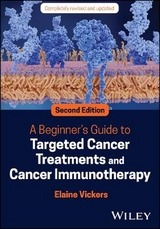
A Beginner's Guide to Targeted Cancer Treatments
Wiley (Verlag)
978-1-119-12679-9 (ISBN)
- Titel ist leider vergriffen;
keine Neuauflage - Artikel merken
Written for anyone who encounters cancer patients, cancer data or cancer terminology, but have no more than a passing knowledge of cell biology. A Beginner's Guide to Targeted Cancer Treatments provides an understanding of how cancer works and the many new treatments available.
Using over 100 original illustrations, this accessible handbook covers the biology and mechanisms behind a huge range of targeted drug treatments, including many new immunotherapies. Dr Vickers translates a complex and often overwhelming topic into something digestible and easily understood. She also explains what cancer is, how it behaves and how our understanding of cancer has changed in recent years.
Each chapter takes the reader through how new cancer drugs work and their benefits and limitations. With the help of this book, readers will be able to better understand more complex, in-depth articles in journals and books and develop their knowledge. This vital resource:
- Offers the latest insights into cancer biology
- Provides a broad understanding of how targeted cancer treatments work
- Describes many of the new immunotherapy approaches to cancer treatment, such as checkpoint inhibitors and CAR-modified T cells
- Helps readers feel confident discussing treatment options with colleagues and patients
- Provides an overview of which treatments are relevant to each of the most common solid tumours and haematological cancers, and the rationale behind them
- Demystifies the jargon - terms such as the EMT, cancer stem cells, monoclonal antibodies, kinase inhibitors, angiogenesis inhibitors etc.
- Explains the resistance mechanisms to many new treatments, including issues such as the way cancer cells diversify and evolve and the complex environment in which they live
DR. ELAINE VICKERS is the Founder of Science Communicated Ltd, an independent company creating courses and educational materials that explain cancer biology and the science behind targeted cancer treatments. In partnership with numerous hospitals, institutes, charities, companies and clinical trials units, her teaching reaches many hundreds of nurses, doctors, pharmacists and clinical trials coordinators each year. Dr. Vickers has a degree in Medical Science from the University of Birmingham and a PhD in Molecular Biology from the University of Manchester. She has been working as a science educator and writer for over fifteen years.
CHAPTER 1 An Introduction to Cancer Cell Biology and Genetics, 1
1.1 Introduction, 1
1.2 DNA Damage is the Cause of Every Cancer, 2
1.3 The Defining Features (Hallmarks) of Cancer Cells, 15
1.4 Genetic Variation among Cancer Cells in a Single Tumor, 16
1.5 The Cancer Microenvironment, 17
1.6 Cancer Spread/Metastasis, 19
1.7 Cancer Stem Cells, 23
1.8 Obstacles that Prevent us from Curing Cancer, 24
1.9 Final Thoughts, 28
CHAPTER 2 Introducing Targeted Cancer Treatments, 33
2.1 Introduction, 34
2.2 Monoclonal Antibodies, 36
2.3 Kinase Inhibitors, 48
2.4 Final Thoughts, 60
CHAPTER 3 Treatments That Block Proteins Involved in Cell Communication, 65
3.1 Introduction, 65
3.2 Introducing Growth Factor Receptors, 67
3.3 Drugs That Target EGFR, 75
3.4 Drugs That Target HER2, 81
3.5 Drugs That Block Other Growth Factor Receptors, 85
3.6 Introduction to Signaling Pathways as a Target for Cancer Therapy, 86
3.7 Targeting the MAPK Signaling Pathway, 87
3.8 Targeting the PI3K/AKT/mTOR Signaling Pathway, 94
3.9 Targeting JAK-STAT Pathway, 100
3.10 Final Thoughts, 103
CHAPTER 4 Drugs That Target: Angiogenesis, Fusion Proteins, Poly-ADP Ribose Polymerase (PARP), Hedgehog Signaling, and CDKs, 111
4.1 Angiogenesis Inhibitors: Introduction, 112
4.2 Drugs that Block Fusion Proteins: Bcr-Abl, Anaplastic Lymphoma Kinase (ALK), RET, and ROS1, 122
4.3 PARP Inhibitors, 127
4.4 Hedgehog Pathway Inhibitors, 134
4.5 Cyclin-Dependent Kinase (CDK) Inhibitors, 139
4.6 Final Thoughts, 145
CHAPTER 5 Immunotherapies for Cancer, 151
5.1 Introduction, 152
5.2 A Bit About Cancer and the Immune System, 154
5.3 Checkpoint Inhibitors, 160
5.4 Adoptive Cell Transfer, 168
5.5 Modified Bi-specific Antibodies, 175
5.6 Therapeutic Cancer Vaccines, 176
5.7 The Future of Immunotherapy, 181
CHAPTER 6 Targeted Treatments for Common Solid Tumors, 187
6.1 Introduction, 188
6.2 Targeted Treatments for Breast Cancer, 188
6.3 Targeted Treatments for Prostate Cancer, 200
6.4 Targeted Treatments for Lung Cancer, 204
6.5 Targeted Treatments for Bowel Cancer, 214
6.6 Targeted Treatments for Malignant Melanoma Skin Cancer, 220
6.7 Targeted Treatments for Kidney Cancer, 225
6.8 Targeted Treatments for Head and Neck Cancer, 231
6.9 Targeted Treatments for Brain Tumors, 235
6.10 Targeted Treatments for Bladder Cancer, 236
6.11 Targeted Treatments for Pancreatic Cancer, 240
6.12 Final Thoughts, 244
CHAPTER 7 Targeted Treatments for Hematological Cancers, 259
7.1 Introduction, 259
7.2 A Bit about Hematological Cancers, 260
7.3 Antibody-Based Treatments that Target CD Antigens, 274
7.4 Drugs that Block BCR Signaling, 287
7.5 Bcr-Abl Inhibitors, 292
7.6 Drugs that Block the Proteasome, 294
7.7 Thalidomide and its Derivatives, 297
7.8 JAK2 Inhibitors, 298
7.9 Bcl-2 Inhibitors, 299
7.10 FLT3 and KIT Inhibitors, 301
7.11 IDH2 Inhibitors, 304
7.12 CAR-Modified T Cell Therapy, 304
7.13 Final Thoughts, 304
Appendix, 313
Glossary of Terms, 315
Index 329
| Erscheinungsdatum | 31.08.2018 |
|---|---|
| Verlagsort | Chicester |
| Sprache | englisch |
| Gewicht | 666 g |
| Einbandart | kartoniert |
| Themenwelt | Medizin / Pharmazie ► Medizinische Fachgebiete ► Onkologie |
| Medizin / Pharmazie ► Pflege | |
| Schlagworte | Krebsbehandlung • Medikamentöse Tumortherapie • Onkologie |
| ISBN-10 | 1-119-12679-7 / 1119126797 |
| ISBN-13 | 978-1-119-12679-9 / 9781119126799 |
| Zustand | Neuware |
| Informationen gemäß Produktsicherheitsverordnung (GPSR) | |
| Haben Sie eine Frage zum Produkt? |
aus dem Bereich



